From Manual To Automated- Keyword Research With Python

In the ever-evolving digital world, keyword research plays a pivotal role in crafting content strategies and improving search engine rankings. Traditionally, this process was manual—relying on human effort, intuition, and tools with limited customization. Enter Python, the programming language that has transformed the way we approach SEO. Python empowers even the non-coders among us (yes, you, budding program geeks) to automate keyword research, saving time and delivering better insights.
In this blog, we’ll dive deep into how Python can revolutionize keyword research, offering practical Python scripts, and step-by-step guidance to streamline your SEO game. And because we at Prateeksha Web Design are committed to helping small businesses succeed, we’ll also showcase how this automation can work seamlessly within your workflow. So, grab your coffee, and let’s embark on this Python-powered journey.
Why Automate Keyword Research?

Manual keyword research can be tedious, prone to error, and time-consuming. Automation using Python addresses these challenges by enabling:
- Efficiency: Automating repetitive tasks like fetching search volume, competition, and related keywords.
- Accuracy: Ensuring consistent results with minimal human error.
- Customization: Building workflows tailored to your unique business needs.
- Scalability: Analyzing hundreds of keywords without breaking a sweat.
For example, instead of manually collecting keywords from Google or your competitors’ sites, you can write a Python script to extract, filter, and analyze keywords in bulk. Imagine what that means for a programming geek aiming to save time and focus on strategy!
Step 1: Setting Up Your Python Environment

Before diving into Python scripts for automating keyword research, we need to ensure your environment is ready to code. Think of this as prepping your workspace with the right tools.
1. Install Python
Python is the foundation of everything we’ll be doing. Follow these steps:
-
Download Python:
- Visit python.org.
- Click on the "Downloads" tab. Python will automatically suggest the right version for your operating system (Windows, macOS, or Linux).
-
Install Python:
- Run the downloaded installer file.
- During installation, ensure you check the box that says "Add Python to PATH" (this is crucial to run Python commands from the terminal or command prompt).
- Complete the installation process by clicking “Next.”
-
Verify Installation:
- Open your terminal (Command Prompt for Windows, Terminal for macOS/Linux).
- Type:
python --version - If Python is installed correctly, you’ll see the version number displayed.
2. Install Key Libraries
Python’s true power comes from its libraries—pre-built tools that make coding easier. For keyword research automation, we’ll use these:
pandas: This library is essential for data manipulation, like organizing and cleaning large datasets.beautifulsoup4andrequests: Perfect for web scraping, these help fetch data from websites and parse HTML content.selenium: Used for advanced web scraping, especially when dealing with dynamic websites that require JavaScript interaction.matplotlib: A library for creating graphs and visualizations to make sense of your data.
How to Install Libraries
- Open your terminal or command prompt and type:
pip install pandas beautifulsoup4 requests selenium matplotlib - What does this do?
pipis Python’s package manager, and it fetches these libraries from the Python Package Index (PyPI) and installs them on your system.
Verify Library Installation
- To check if a library is installed, type:
pip show pandas - If it’s installed, you’ll see details about the library, such as the version.
3. Set Up Your IDE
An IDE (Integrated Development Environment) is like a notepad with superpowers for coding. It makes writing, debugging, and running Python scripts easier.
-
Popular IDEs:
- VS Code (Visual Studio Code):
- Download from code.visualstudio.com.
- Install Python extension from the Extensions Marketplace (look for the “Python” extension by Microsoft).
- Jupyter Notebook:
- Install it using
pip:pip install notebook - Launch it by typing:
jupyter notebook - A browser will open where you can create and run Python scripts interactively.
- Install it using
- VS Code (Visual Studio Code):
-
Why use an IDE?
- Syntax highlighting: Makes code easier to read.
- Debugging tools: Helps find and fix errors.
- Run scripts: Easily execute Python code without leaving the interface.
At this point, your Python environment is ready, and you’re armed with the tools needed to automate keyword research like a pro programming geek!
Step 2: Extracting Keywords from Google Suggest

Google Autocomplete is a goldmine for long-tail keywords—phrases that are specific, less competitive, and often more effective for SEO. The Python script provided will automate fetching suggestions from Google.
How It Works
-
Seed Keywords:
- These are your starting points for keyword discovery (e.g., "Python keyword research," "SEO automation").
- The script sends these to Google Autocomplete and retrieves suggestions.
-
Google Autocomplete API:
- This is a hidden feature where Google provides keyword suggestions via a URL. The script uses this URL:
http://suggestqueries.google.com/complete/search?client=firefox&q=<keyword> - Replace
<keyword>with any term to get suggestions.
- This is a hidden feature where Google provides keyword suggestions via a URL. The script uses this URL:
-
Output:
- The script organizes the suggestions into a dictionary format for easy access.
Breaking Down the Python Script
Here’s what each part of the script does:
-
Importing Libraries:
import requests import jsonrequestsfetches data from the Google Autocomplete URL.jsonprocesses the response into a format Python can work with.
-
Defining the Function:
def fetch_google_suggest(keywords): suggestions = {} for keyword in keywords: url = f"http://suggestqueries.google.com/complete/search?client=firefox&q={keyword}" response = requests.get(url) if response.status_code == 200: data = json.loads(response.content.decode('utf-8')) suggestions[keyword] = data[1] return suggestions- Input: A list of seed keywords.
- Logic: For each keyword, it sends a request to Google Autocomplete and processes the JSON response to extract suggestions.
- Output: A dictionary where the seed keyword is the key, and the suggestions are the values.
-
Using the Function:
seed_keywords = ['Python keyword research', 'SEO automation', 'digital marketing'] results = fetch_google_suggest(seed_keywords)- This initializes a list of seed keywords and runs the function.
-
Displaying Results:
for seed, keywords in results.items(): print(f"Suggestions for '{seed}': {keywords}")- Loops through the dictionary to print suggestions for each seed keyword.
Running the Script
- Save the script as
google_suggest.py. - Run it in your terminal:
python google_suggest.py - You’ll see outputs like:
Suggestions for 'Python keyword research': ['Python keyword research tools', 'Python SEO automation', 'keyword analysis Python'] Suggestions for 'SEO automation': ['SEO automation tools', 'SEO automation software', '<a href="/blog/revolutionize-your-seo-game-python-for-backlink-analysis-automation">automate SEO tasks Python</a>']
Why This Script Matters
- Saves Time: No need to manually type keywords into Google.
- Boosts Creativity: Generates fresh keyword ideas effortlessly.
- Customizable: Tailor the script to fetch suggestions for niche topics.
This script is a must-have for anyone diving into keyword discovery automation with Python. With the foundational setup done, you’re ready to scale up your keyword research!

Step 3: Using APIs for Bulk Keyword Data
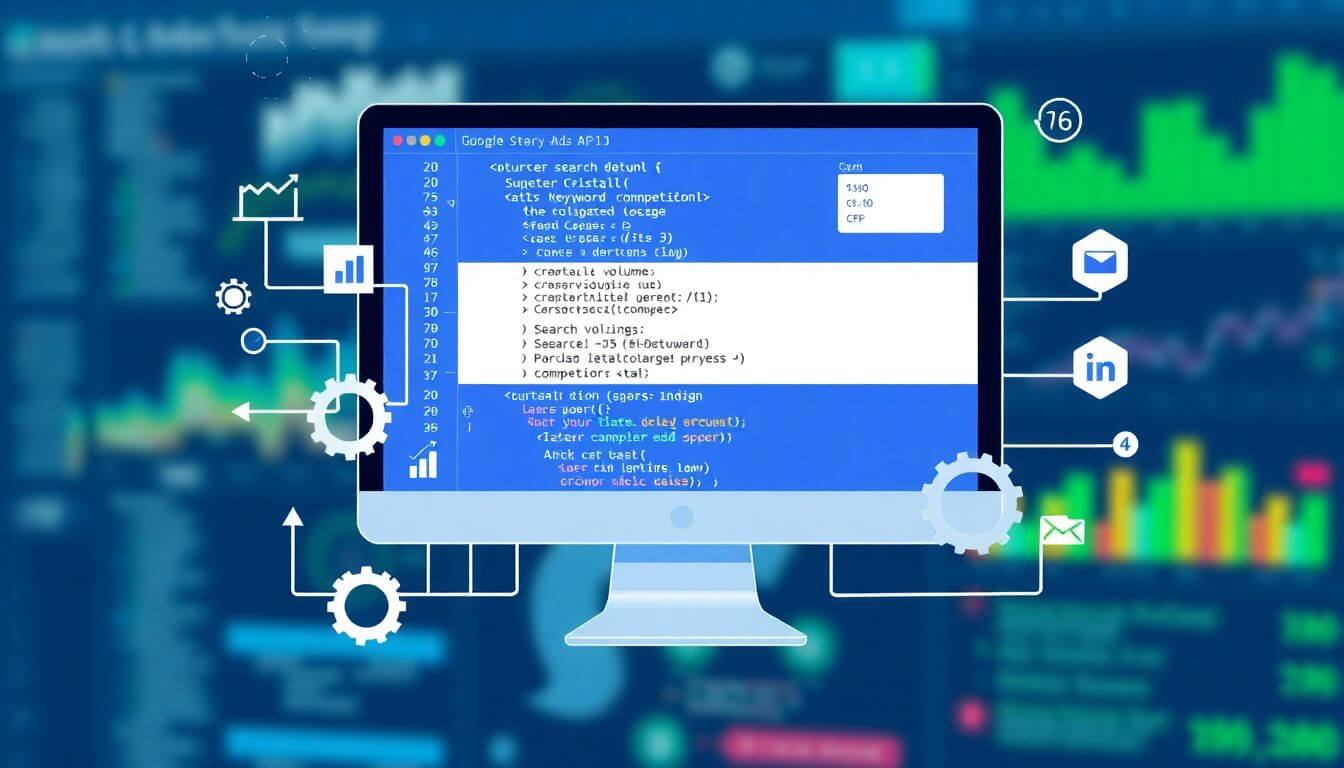
APIs (Application Programming Interfaces) are powerful tools for retrieving data directly from platforms like Google Ads or SEMrush. They provide structured and real-time access to metrics such as search volume, competition, and CPC (Cost Per Click), essential for keyword analysis.
In this section, we’ll focus on the Google Ads API and how you can use it to fetch bulk keyword data for your SEO strategy.
Why Use APIs for Keyword Data?
- Efficiency: Automate the process of collecting metrics for hundreds or thousands of keywords.
- Accuracy: Access real-time data directly from the source.
- Customization: Retrieve specific metrics tailored to your needs, such as volume, competition, or trends.
- Scalability: Handle bulk requests without manual effort.
Google Ads API: Overview
The Google Ads API is a robust interface for accessing keyword data. With it, you can:
- Fetch search volumes for keywords.
- Analyze competition in the bidding space.
- Retrieve CPC estimates, helping you plan ad budgets.
However, using this API requires:
- Google Ads Account: Ensure you have access to a Google Ads account.
- API Key: Obtain API credentials via the Google Ads Developer Console.
- Setup File: Create a
googleads.yamlfile with your credentials for authentication.
Detailed Walkthrough of the Example Script
1. Importing the googleads Library
This library handles interactions with the Google Ads API. Install it using:
pip install google-ads
2. Setting Up the AdWords Client
client = adwords.AdWordsClient.LoadFromStorage('googleads.yaml')
- The
AdWordsClient.LoadFromStoragefunction reads credentials from thegoogleads.yamlfile. This file typically contains:adwords: developer_token: YOUR_DEVELOPER_TOKEN client_customer_id: YOUR_CUSTOMER_ID client_id: YOUR_CLIENT_ID client_secret: YOUR_CLIENT_SECRET refresh_token: YOUR_REFRESH_TOKEN - Replace placeholders with actual values from your Google Ads account.
3. Accessing the Targeting Idea Service
targeting_idea_service = client.GetService('TargetingIdeaService', version='v201809')
- The Targeting Idea Service is used to fetch keyword-related data like volume, competition, and CPC.
4. Defining the Selector
selector = {
'searchParameters': [{'xsi_type': 'RelatedToQuerySearchParameter', 'queries': keywords}],
'ideaType': 'KEYWORD',
'requestType': 'STATS',
}
searchParameters: Specifies the input keywords (in this case, a list of seed keywords like'Python automation').ideaType: Defines the type of ideas you’re requesting—here, it'sKEYWORD.requestType: Requests statistical data (like search volume and competition) for the keywords.
5. Fetching Data
page = targeting_idea_service.get(selector)
- This line sends the request to Google Ads and fetches a page of results.
6. Parsing the Response
for result in page['entries']:
data = result['data']
print(f"Keyword: {data['KEYWORD_TEXT']['value']} - Volume: {data['SEARCH_VOLUME']['value']}")
- Each result contains data for a specific keyword, including:
KEYWORD_TEXT: The keyword itself.SEARCH_VOLUME: Estimated monthly searches.
Example Output
For the seed keywords ['Python automation', 'SEO tools', 'keyword research'], the script might output:
Keyword: Python automation - Volume: 1200
Keyword: SEO tools - Volume: 5000
Keyword: keyword research - Volume: 8000
Limitations
- Complex Setup: Requires API access and configuration.
- Quota Restrictions: Google Ads API has usage limits depending on your account type.
- Paid Account: Some features may only be available for Google Ads paid accounts.
This script is a game-changer for Python for marketing automation enthusiasts, enabling precise and efficient keyword analysis.
Step 4: Scraping Competitor Keywords
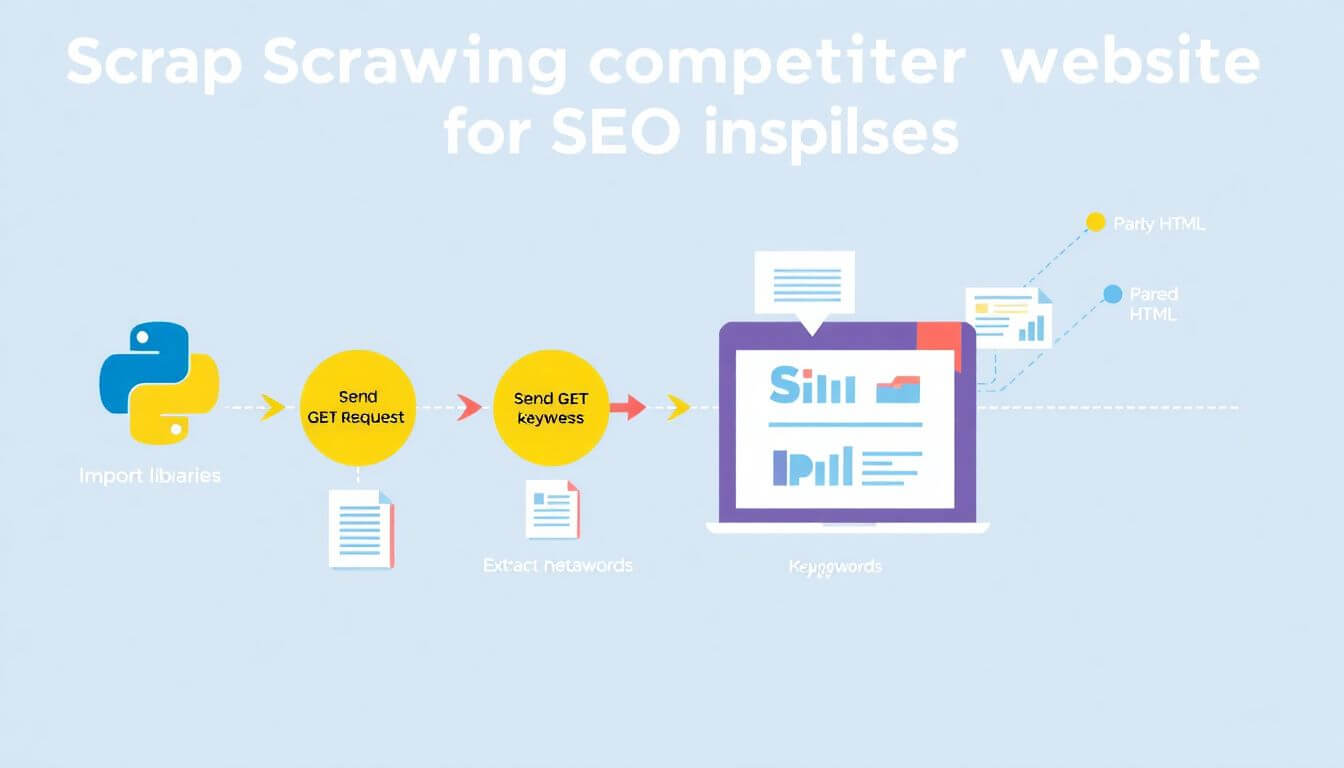
Analyzing competitor websites is crucial for gaining insights into their SEO strategy. By scraping meta keywords or content, you can uncover the keywords they’re targeting and adapt your strategy accordingly.
Why Scrape Competitor Keywords?
- Understand Competitor Strategy: Identify which keywords drive traffic to their sites.
- Discover New Opportunities: Find keywords they’re targeting that you’ve missed.
- Stay Ahead: Track changes in their strategy over time.
The Role of BeautifulSoup
BeautifulSoup is a Python library for parsing HTML and XML documents. It simplifies web scraping by providing easy access to page elements like <meta> tags.
Detailed Walkthrough of the Example Script
1. Importing Libraries
from bs4 import BeautifulSoup
import requests
BeautifulSoup: Parses HTML content.requests: Sends HTTP requests to fetch the webpage’s HTML.
Install these libraries using:
pip install beautifulsoup4 requests
2. Sending a GET Request
response = requests.get(url)
- Sends a request to the specified
url(competitor’s website). - The response contains the HTML source code of the page.
3. Checking the Response
if response.status_code == 200:
- Ensures the request was successful (status code
200means OK).
4. Parsing the HTML
soup = BeautifulSoup(response.text, 'html.parser')
- Converts the raw HTML into a
BeautifulSoupobject for easier navigation.
5. Extracting Meta Keywords
meta_keywords = soup.find('meta', attrs={'name': 'keywords'})
if meta_keywords:
return meta_keywords['content']
- Searches for the
<meta>tag with the attributename="keywords". - If found, retrieves the content (a comma-separated list of keywords).
6. Example Output
For a competitor URL, the script might return:
Keywords: <a href="/blog/python-for-digital-marketers-automating-seo-and-analytics-tasks">Python SEO tools</a>, automate keyword research, digital marketing Python
Limitations
- Not All Websites Use Meta Keywords: Modern SEO often focuses on other elements like headers and content.
- Ethical Considerations: Scraping is allowed for publicly available data, but always review the website's robots.txt file and terms of use.
- Dynamic Content: If keywords are dynamically generated, consider using
seleniumfor advanced scraping.
Step 5: Keyword Clustering with Machine Learning
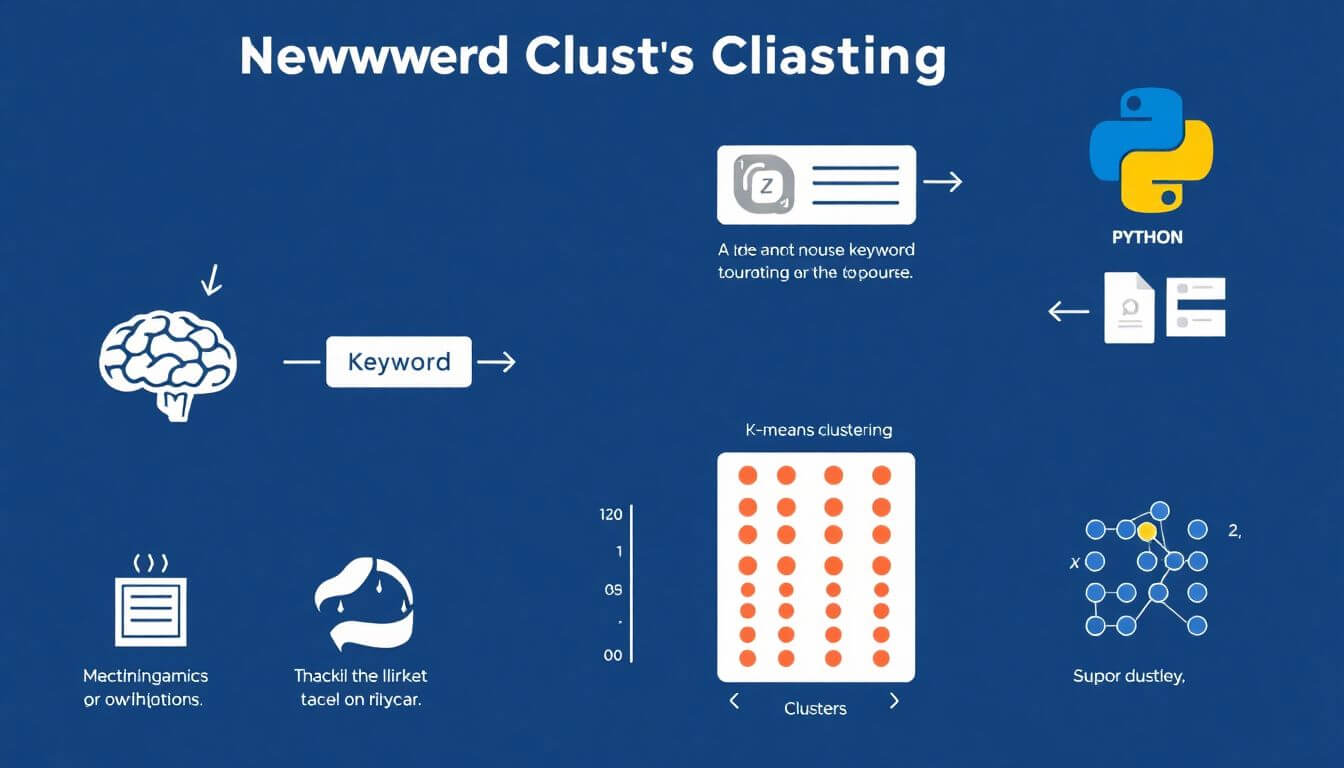
Keyword clustering is the process of grouping similar keywords together based on their semantic relationships. This is critical for improving your content strategy, as it helps:
- Identify themes and topics for your content.
- Organize keywords into logical groups for better targeting.
- Avoid content overlap and keyword cannibalization.
By using machine learning with the scikit-learn library, you can automate keyword clustering efficiently.
Why Use Machine Learning for Keyword Clustering?
- Scalability: Easily cluster thousands of keywords without manual sorting.
- Accuracy: Leverage mathematical models to group keywords by their semantic similarity.
- Customization: Adjust the number of clusters to fit your content strategy.
Overview of the Python Script
The provided script uses TF-IDF (Term Frequency-Inverse Document Frequency) and K-Means Clustering:
- TF-IDF: Converts text data (keywords) into numerical features that machine learning models can understand. It highlights important terms in each keyword.
- K-Means Clustering: Groups similar keywords based on their numerical representations.
Breaking Down the Script
1. Import Libraries
from sklearn.feature_extraction.text import TfidfVectorizer
from sklearn.cluster import KMeans
TfidfVectorizer: Converts keywords into a numerical matrix using TF-IDF scores.KMeans: A clustering algorithm that groups data points intokclusters.
Install scikit-learn using:
pip install scikit-learn
2. Define the Clustering Function
def cluster_keywords(keywords, num_clusters=3):
vectorizer = TfidfVectorizer(stop_words='english')
X = vectorizer.fit_transform(keywords)
model = KMeans(n_clusters=num_clusters, random_state=42)
model.fit(X)
clusters = {i: [] for i in range(num_clusters)}
for i, label in enumerate(model.labels_):
clusters[label].append(keywords[i])
return clusters
-
TfidfVectorizer(stop_words='english'):- Converts the list of keywords into a TF-IDF matrix.
- Removes common words (stop words) like “and,” “the,” or “for,” which don’t contribute to meaning.
-
model = KMeans(n_clusters=num_clusters, random_state=42):- Initializes a K-Means clustering model with the specified number of clusters (
num_clusters).
- Initializes a K-Means clustering model with the specified number of clusters (
-
model.fit(X):- Fits the model to the TF-IDF matrix (
X), assigning each keyword to a cluster.
- Fits the model to the TF-IDF matrix (
-
clusters = {i: [] for i in range(num_clusters)}:- Creates a dictionary to store keywords grouped by their cluster labels.
-
for i, label in enumerate(model.labels_())::- Iterates through the model’s predicted labels to assign keywords to their respective clusters.
3. Apply the Function to Keywords
keywords = ['Python SEO tools', 'automate keyword research Python', 'Python for digital marketing', 'SEO automation']
clusters = cluster_keywords(keywords)
- Define a list of keywords you want to cluster.
- Call the
cluster_keywordsfunction.
4. Print the Clusters
for cluster, words in clusters.items():
print(f"Cluster {cluster}: {words}")
- Displays the grouped keywords for each cluster.
Output Example
For the provided list of keywords:
Cluster 0: ['SEO automation']
Cluster 1: ['Python SEO tools', 'automate keyword research Python']
Cluster 2: ['Python for digital marketing']
This output helps identify topics/themes for content creation.
Applications
- Content Planning:
- Create blog posts for each cluster.
- Organize PPC campaigns around keyword groups.
- SEO Optimization:
- Avoid keyword cannibalization by targeting clusters instead of individual keywords.
- Data Insights:
- Analyze trends in your keyword dataset.
Step 6: Visualizing Keyword Rankings
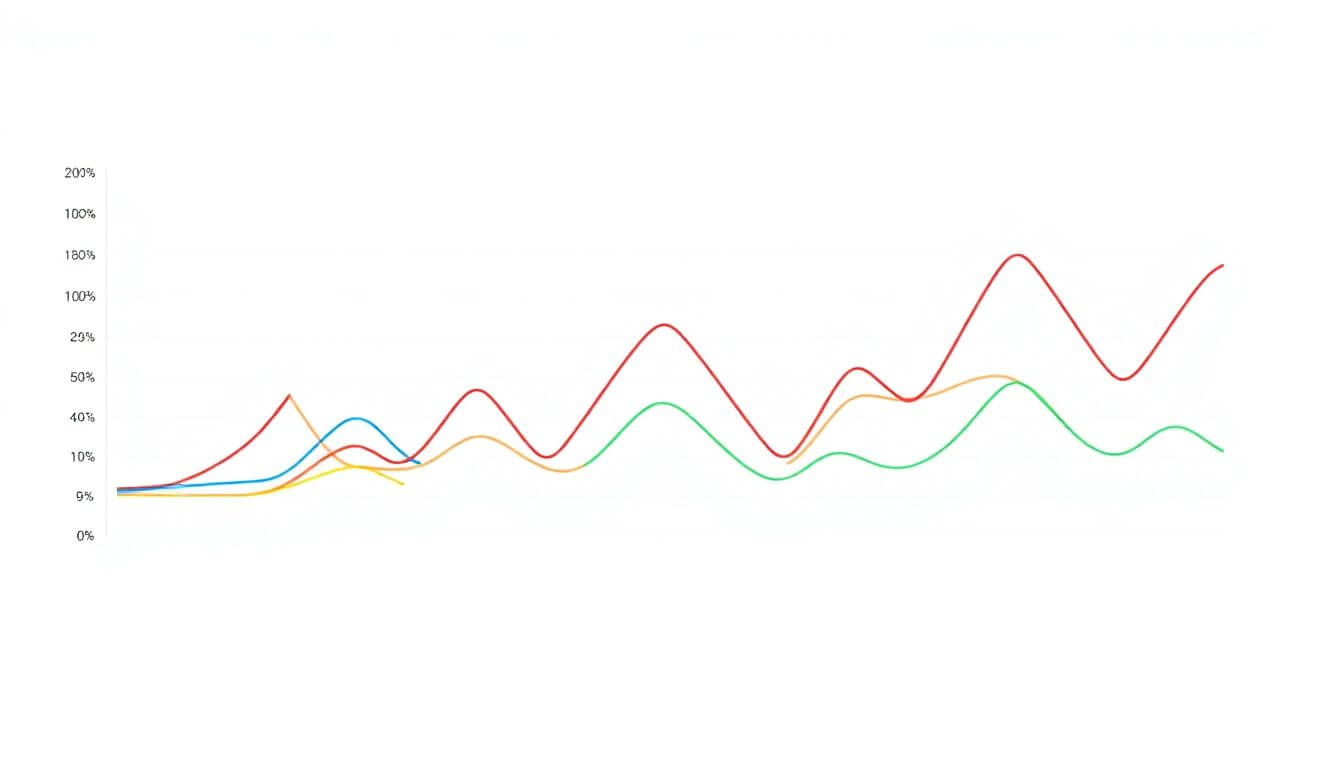
Tracking keyword rankings over time is vital for understanding the success of your SEO strategy. Using Python and Matplotlib, you can create a line chart to visualize changes in rankings.
Breaking Down the Script
1. Import Matplotlib
import matplotlib.pyplot as plt
matplotlibis a Python library for creating visualizations. Install it using:pip install matplotlib
2. Define the Plot Function
def plot_keyword_rankings(data):
for keyword, rankings in data.items():
plt.plot(rankings, label=keyword)
plt.xlabel('Time')
plt.ylabel('Rank')
plt.title('Keyword Ranking Over Time')
plt.legend()
plt.show()
- Input:
- A dictionary where keys are keywords and values are lists of rankings over time.
- Example:
keyword_rankings = { 'Python SEO tools': [10, 8, 5, 3], 'automate keyword research': [15, 12, 10, 7] }
- Logic:
- Iterates through the dictionary, plotting each keyword’s rankings.
- Adds labels (
xlabel,ylabel,title) for clarity.
- Output:
- Displays a line chart.
3. Call the Function
plot_keyword_rankings(keyword_rankings)
Output Visualization
The line chart might look like this:
- X-axis: Time (e.g., weekly or monthly intervals).
- Y-axis: Rankings (lower is better for SEO).
- Lines: Show how each keyword’s ranking improves or declines over time.
Benefits
- Trend Analysis: Identify which keywords are improving or losing rankings.
- Performance Insights: Measure the effectiveness of your SEO efforts.
- Data-Driven Decisions: Adjust strategies based on ranking trends.
Step 7: Beyond Keywords – Automating SEO Reports
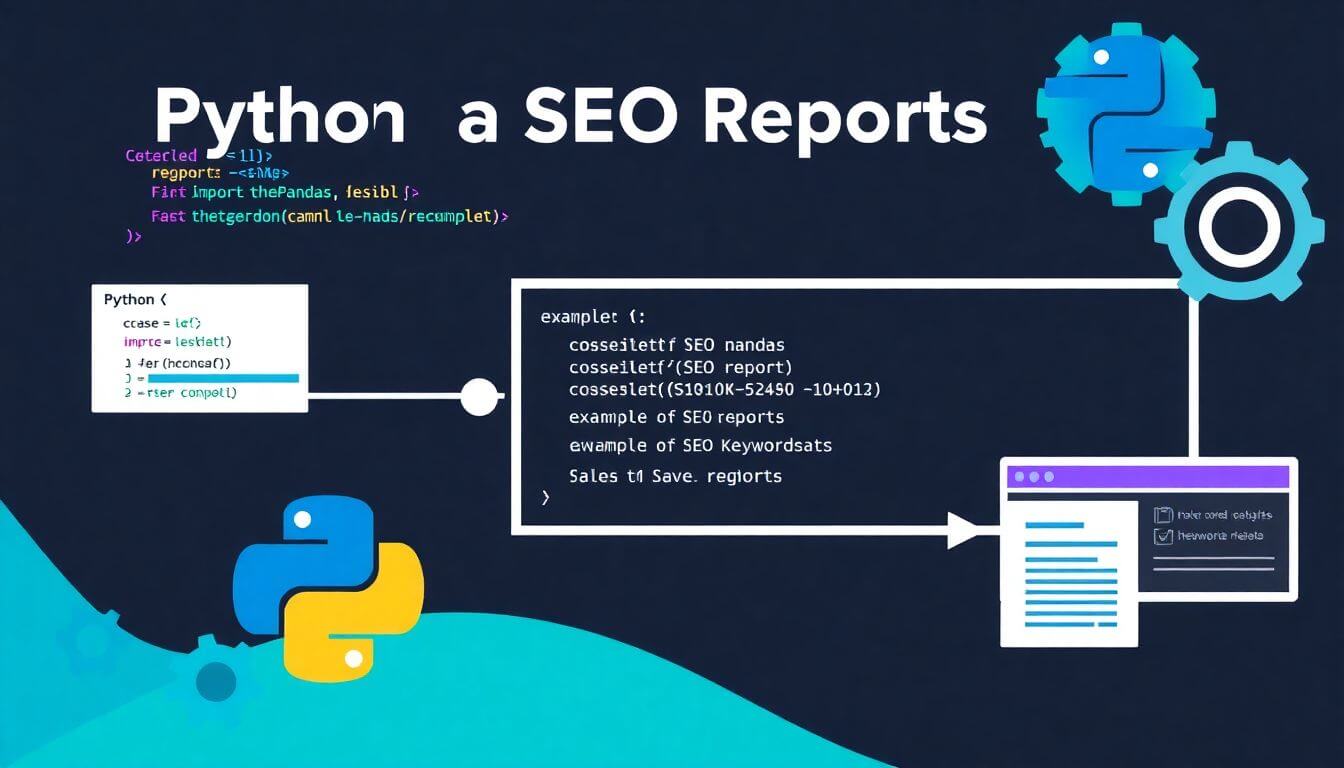
Creating SEO reports manually can be time-consuming. Automating the process using Python and Pandas saves time and ensures consistency.
Breaking Down the Script
1. Import Pandas
import pandas as pd
pandasis a library for data manipulation and analysis. Install it using:pip install pandas
2. Define the Report Function
def generate_seo_report(data, filename='seo_report.csv'):
df = pd.DataFrame(data)
df.to_csv(filename, index=False)
print(f"Report saved as {filename}")
- Input:
- A dictionary containing keyword data:
seo_data = { 'Keyword': ['Python SEO tools', 'automate keyword research', 'digital marketing Python'], 'Volume': [1200, 950, 700], 'Competition': [0.4, 0.5, 0.3], 'CPC': [0.8, 1.0, 0.6] }
- A dictionary containing keyword data:
- Logic:
- Converts the dictionary into a Pandas DataFrame.
- Saves the DataFrame as a CSV file using
to_csv().
3. Call the Function
generate_seo_report(seo_data)
Output
- A CSV file named
seo_report.csvcontaining:Keyword,Volume,Competition,CPC Python SEO tools,1200,0.4,0.8 automate keyword research,950,0.5,1.0 digital marketing Python,700,0.3,0.6
Benefits
- Consistency: Generate uniform reports.
- Scalability: Handle large datasets efficiently.
- Professional Presentation: Share reports with clients or stakeholders.
By integrating these steps into your workflow, you can elevate your SEO game, automate time-consuming tasks, and make data-driven decisions with ease.
Conclusion: The Power of Python in Keyword Research
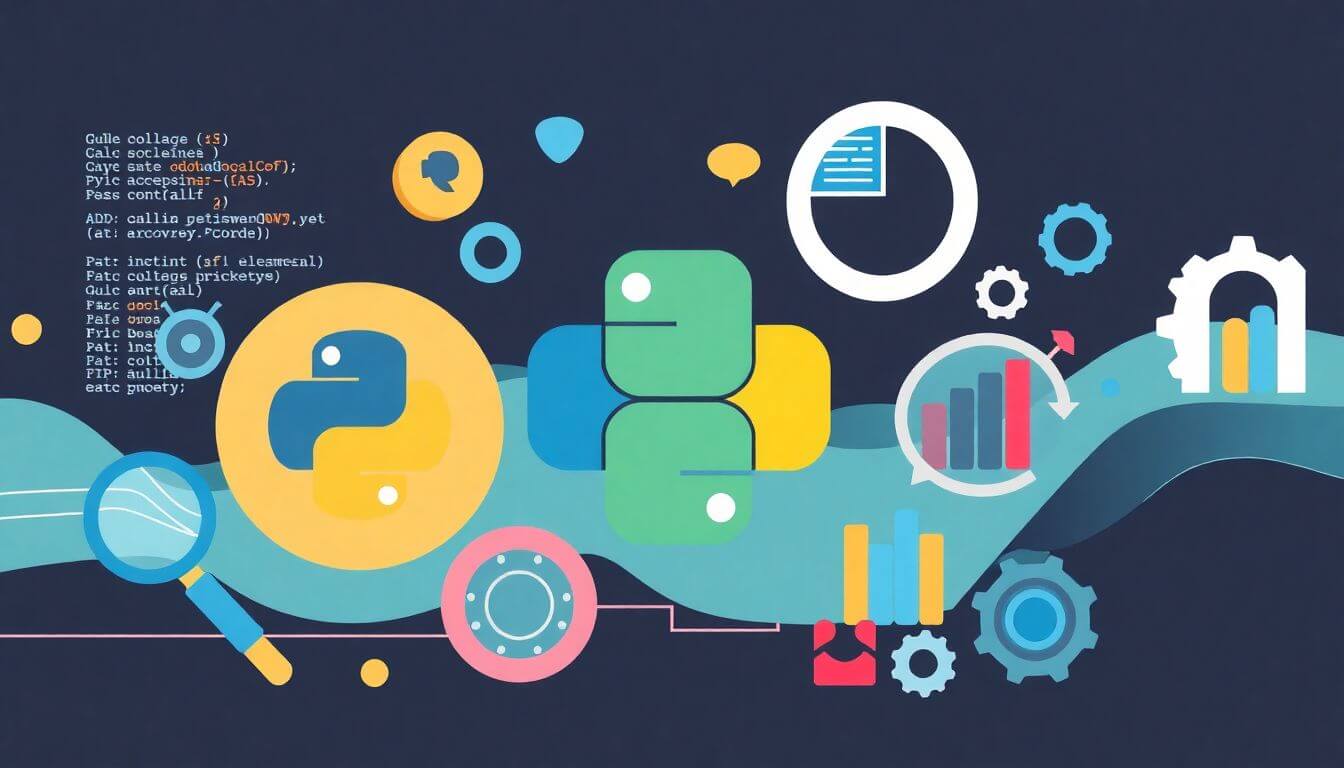
From extracting keywords to clustering, tracking rankings, and generating reports, Python offers limitless possibilities for keyword research automation tools Python enthusiasts. Whether you’re a geeks program beginner or an experienced programming geek, these scripts can supercharge your SEO strategy.
At Prateeksha Web Design, we specialize in integrating cutting-edge technologies like Python for marketing automation into our clients’ workflows, ensuring they stay ahead in the digital race. Ready to elevate your SEO game? Let’s collaborate!
About Prateeksha Web Design
- Automation in keyword research
- Python for data extraction and analysis
- Transition from manual to automated processes
- Enhanced efficiency and accuracy
- Prateeksha Web Design's expertise in streamlining keyword research
Interested in learning more? Contact us today. For more resources on Python and SEO, check Search Engine Journal, Moz, and HubSpot.
FAQs
-
What is keyword research and why is it important for SEO? Keyword research is the process of finding and analyzing search terms that people use in search engines. It is crucial for SEO because targeting the right keywords helps improve search engine rankings and drive relevant traffic to a website.
-
How can Python automate keyword research? Python can automate keyword research by using scripts to fetch keyword data like search volume, competition metrics, and related suggestions from APIs or web scraping sources, significantly reducing the time and effort required compared to manual methods.
-
What libraries are recommended for keyword research automation in Python? Recommended Python libraries for keyword research automation include
pandasfor data manipulation,beautifulsoup4andrequestsfor web scraping,seleniumfor interacting with dynamic websites, andmatplotlibfor visualizing data. -
How can I analyze competitor keywords using Python? You can analyze competitor keywords by scraping their website's meta tags or content using libraries like
BeautifulSoupin Python to uncover the keywords they are targeting, which can inform your own SEO strategy. -
What are the benefits of automating SEO reports with Python? Automating SEO reports with Python enhances consistency, saves time, allows for the handling of large datasets efficiently, and provides professional and clear reports to stakeholders.
